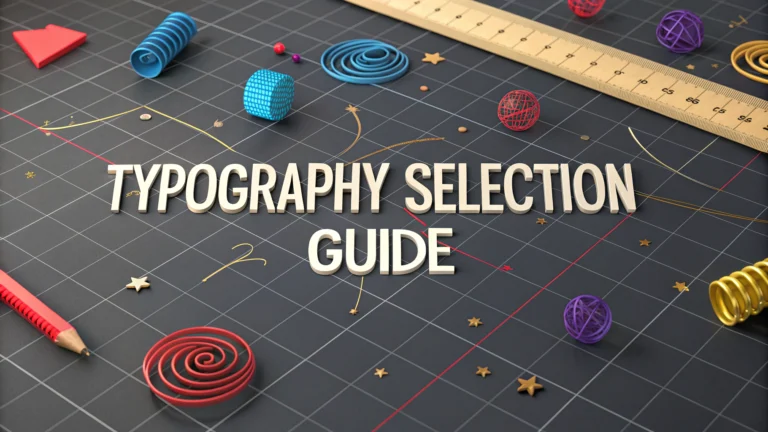Typography forms the foundation of effective logo design, directly impacting brand recognition and memorability.
Understanding font psychology helps create logos that align with your brand’s personality and message.
Font Categories for Logos
- Serif: Traditional, reliable, established
- Sans-serif: Modern, clean, approachable
- Script: Elegant, personal, creative
- Display: Unique, attention-grabbing, themed
- Monospace: Technical, precise, structured
Typography Selection Tips
Start with black and white designs to ensure the typography works at its most basic level.
Test your font choices at different sizes to confirm legibility across all applications.
Limit your logo to maximum two typefaces to maintain clarity and professionalism.
Common Typography Mistakes
- Using trendy fonts that quickly become outdated
- Selecting fonts that are too decorative for business applications
- Poor spacing between letters (kerning)
- Ignoring scalability requirements
Recommended Professional Fonts
| Style | Font Options | Best For |
|---|---|---|
| Corporate | Helvetica, Futura, Gotham | Professional services, tech companies |
| Creative | Brandon Grotesque, Proxima Nova | Design agencies, startups |
| Luxury | Didot, Baskerville | Fashion, high-end retail |
Technical Considerations
- Check font licensing for commercial use
- Ensure font compatibility across different platforms
- Consider web font performance
- Create vector versions for scalability
Purchase professional fonts from reputable sources like MyFonts, Adobe Fonts, or Typography.com.
Test your logo typography across different backgrounds, sizes, and applications before finalizing the design.
Tools for Typography Testing
- FontBook: Font management and comparison
- WhatTheFont: Font identification
- TypeKit: Web font integration
- FontSquirrel: Free font resources
Advanced Typography Principles
Hierarchy and Visual Weight
Establish clear hierarchical relationships between different text elements in your logo through size, weight, and spacing variations.
- Primary text: Largest and most prominent
- Secondary text: Supporting information
- Tertiary elements: Additional details or taglines
Color and Contrast
Typography color choices impact readability and brand perception. Consider:
- Color psychology alignment with brand values
- Contrast ratios for accessibility
- Color variations for different applications
Logo Typography in Motion
Modern logos need to work in animated environments:
- Consider how letters can be animated
- Maintain readability during transitions
- Design with social media applications in mind
Implementation Strategy
Brand Guidelines
Document typography specifications including:
- Font family and weights
- Minimum size requirements
- Spacing and alignment rules
- Usage restrictions
Conclusion
Successful logo typography requires careful consideration of brand personality, technical requirements, and practical applications. Regular evaluation and updates ensure your typography remains effective while maintaining brand recognition.
Remember to document all typography decisions in your brand guidelines and regularly test across different mediums to maintain consistency and impact.
FAQs
- What are the key factors to consider when choosing typography for a logo?
Legibility, brand personality, scalability, spacing, uniqueness, versatility across different media, and compatibility with the overall design are essential factors when selecting logo typography. - Should I use serif or sans-serif fonts for my logo design?
The choice depends on your brand identity. Serif fonts convey tradition, sophistication, and reliability, while sans-serif fonts project modernity, simplicity, and cleanliness. - How many fonts should I use in a logo design?
Best practice is to limit typography to one or two fonts maximum in a logo design. Using too many fonts can create visual confusion and reduce brand recognition. - What’s the minimum font size for logo typography to maintain legibility?
Logo typography should remain legible at sizes as small as 0.5 inches (12.7mm) for print and 72 pixels for digital display to ensure versatility across applications. - Can I modify existing fonts for my logo design?
Yes, but ensure you have proper licensing rights. Many font licenses require separate permissions for modification and logo use. Custom modifications can help create unique brand identity. - What are display fonts and when should I use them in logos?
Display fonts are decorative typefaces designed for large-scale use. They’re suitable for logos when you want to create strong visual impact, but should be used cautiously as they can affect legibility. - How do I ensure my logo typography works across different platforms?
Choose fonts that remain clear across print, digital, and various background colors. Test the logo at different sizes and on multiple platforms before finalizing. - What’s the importance of kerning in logo typography?
Kerning, the adjustment of space between letters, is crucial for visual balance and readability in logo design. Proper kerning ensures professional appearance and prevents awkward letter spacing. - Should I purchase premium fonts for my logo design?
Premium fonts often offer better quality, uniqueness, and comprehensive licensing for commercial use. While not always necessary, they can provide distinction and prevent legal issues. - How do I ensure my logo typography reflects my brand’s personality?
Research font psychology and historical context. Match typography characteristics (weight, style, shape) with brand attributes. Modern brands might use clean sans-serifs, while luxury brands often choose elegant serifs.







